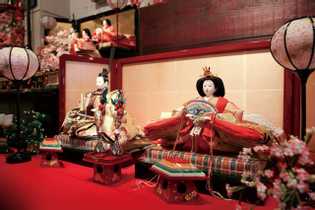ひな祭り - Hinamatsuri (The Doll's Festival)
Hinamatsuri is also called the Girls’ Festival. It is celebrated on March 3rd to wish girls good health and growth. Most families that have girls celebrate by displaying a set of beautifully dressed dolls that represent the members of the ancient imperial court of the Heian Period (794 to 1185). The dolls are displayed on tiers of shelves. The Emperor and the Empress, called dairi-bina, are displayed on the top shelf, three ladies in waiting (sannin-kanjo) are on the second shelf, and there are five court musicians (gonin-bayahi) on the third shelf. There are two eminent lords holding the offices of government ministers (udaijin and sadaijin) on the fourth shelf, and there are three servants below them. Sometimes, the lower shelves also display miniature articles such as furniture, food, and tableware. The families prepares special dishes and also make offerings to the dolls including lozenge rice cakes (hishi-mochi) and white sake that is made from sake and rice malt to ! celebrate the Doll’s Festival. The Doll’s Festival is also called momo-no-sekku, which means the Peach Festival, as it is celebrated in the season when the peach blossoms bloom beautifully.
ひな祭りは3月3日に行われる女児のための節句です。女児のいる家庭では、この日に女児の健康と成長を願い、ひな人形を飾ってお祝いをします。ひな人形は平安時代(794〜1185)の宮廷の衣装を着せた一群の人形で、これを数段の段に並べて飾ります。最上段に天皇・皇后ひな(内裏びな)、その下に三人官女、五人ばやし、二人の随身、三人の召し使いを並べます。さらにその下には、家具や食物、食器の模型を飾ることもあります。ひな人形にはひしもち、白酒などを供え、家族で食事をして祝います。ひな祭りは、桃の花が美しく咲く季節の行事であることから桃の節句とも呼ばれています。
